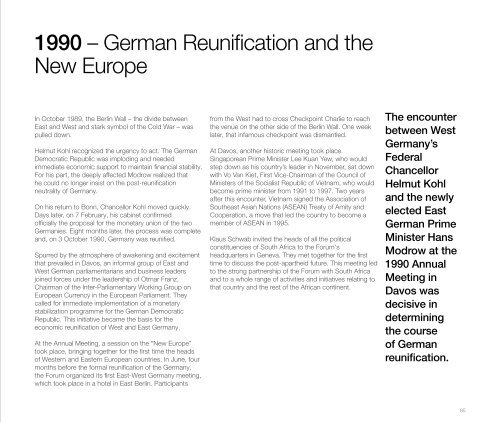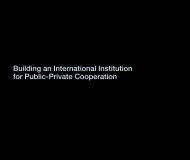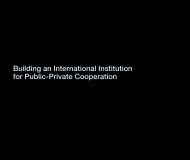second try
ydfgydfg
ydfgydfg
Create successful ePaper yourself
Turn your PDF publications into a flip-book with our unique Google optimized e-Paper software.
1990 – German Reunification and the<br />
New Europe<br />
In October 1989, the Berlin Wall – the divide between<br />
East and West and stark symbol of the Cold War – was<br />
pulled down.<br />
Helmut Kohl recognized the urgency to act. The German<br />
Democratic Republic was imploding and needed<br />
immediate economic support to maintain financial stability.<br />
For his part, the deeply affected Modrow realized that<br />
he could no longer insist on the post-reunification<br />
neutrality of Germany.<br />
On his return to Bonn, Chancellor Kohl moved quickly.<br />
Days later, on 7 February, his cabinet confirmed<br />
officially the proposal for the monetary union of the two<br />
Germanies. Eight months later, the process was complete<br />
and, on 3 October 1990, Germany was reunified.<br />
Spurred by the atmosphere of awakening and excitement<br />
that prevailed in Davos, an informal group of East and<br />
West German parliamentarians and business leaders<br />
joined forces under the leadership of Otmar Franz,<br />
Chairman of the Inter-Parliamentary Working Group on<br />
European Currency in the European Parliament. They<br />
called for immediate implementation of a monetary<br />
stabilization programme for the German Democratic<br />
Republic. This initiative became the basis for the<br />
economic reunification of West and East Germany.<br />
At the Annual Meeting, a session on the “New Europe”<br />
took place, bringing together for the first time the heads<br />
of Western and Eastern European countries. In June, four<br />
months before the formal reunification of the Germany,<br />
the Forum organized its first East-West Germany meeting,<br />
which took place in a hotel in East Berlin. Participants<br />
from the West had to cross Checkpoint Charlie to reach<br />
the venue on the other side of the Berlin Wall. One week<br />
later, that infamous checkpoint was dismantled.<br />
At Davos, another historic meeting took place.<br />
Singaporean Prime Minister Lee Kuan Yew, who would<br />
step down as his coun<strong>try</strong>’s leader in November, sat down<br />
with Vo Van Kiet, First Vice-Chairman of the Council of<br />
Ministers of the Socialist Republic of Vietnam, who would<br />
become prime minister from 1991 to 1997. Two years<br />
after this encounter, Vietnam signed the Association of<br />
Southeast Asian Nations (ASEAN) Treaty of Amity and<br />
Cooperation, a move that led the coun<strong>try</strong> to become a<br />
member of ASEAN in 1995.<br />
Klaus Schwab invited the heads of all the political<br />
constituencies of South Africa to the Forum's<br />
headquarters in Geneva. They met together for the first<br />
time to discuss the post-apartheid future. This meeting led<br />
to the strong partnership of the Forum with South Africa<br />
and to a whole range of activities and initiatives relating to<br />
that coun<strong>try</strong> and the rest of the African continent.<br />
The encounter<br />
between West<br />
Germany’s<br />
Federal<br />
Chancellor<br />
Helmut Kohl<br />
and the newly<br />
elected East<br />
German Prime<br />
Minister Hans<br />
Modrow at the<br />
1990 Annual<br />
Meeting in<br />
Davos was<br />
decisive in<br />
determining<br />
the course<br />
of German<br />
reunification.<br />
85




